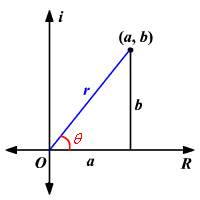Writing Complex Numbers In Polar Form
- Home
Polar Form of a Complex Number
The polar form of a complex number is another way to represent a complex number. The form is called the rectangular coordinate form of a complex number.

The horizontal axis is the real axis and the vertical axis is the imaginary axis. We find the real and complex components in terms of and where is the length of the vector and is the angle made with the real axis.
From Pythagorean Theorem :
By using the basic trigonometric ratios :
and .
Multiplying each side by :
The rectangular form of a complex number is given by
.
Substitute the values of and .
In the case of a complex number, represents the absolute value or modulus and the angle is called the argument of the complex number.
This can be summarized as follows:
The polar form of a complex number is , where , , and for and or for .
Example:
Express the complex number in polar form.
The polar form of a complex number is .
So, first find the absolute value of .
Now find the argument .
Since , use the formula .
Note that here is measured in radians.
Therefore, the polar form of is about .
Writing Complex Numbers In Polar Form
Source: https://www.varsitytutors.com/hotmath/hotmath_help/topics/polar-form-of-a-complex-number
Posted by: keegansuching.blogspot.com

0 Response to "Writing Complex Numbers In Polar Form"
Post a Comment